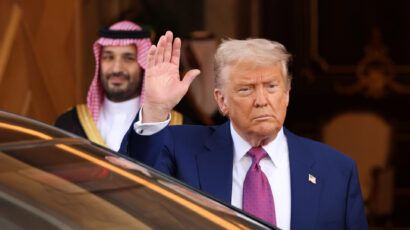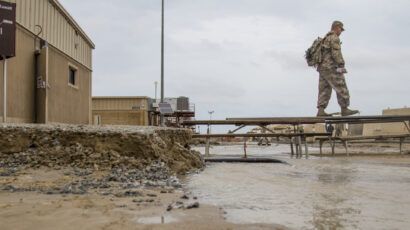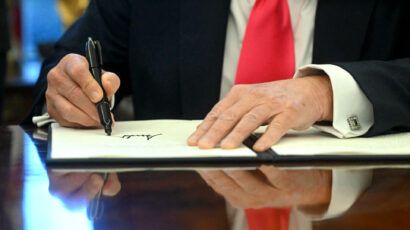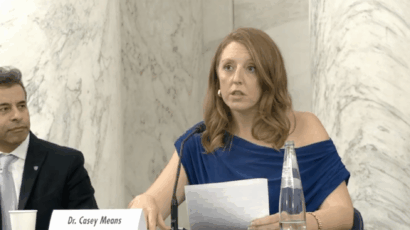The day after the Ukraine war
By Robert J. Goldston | April 6, 2022
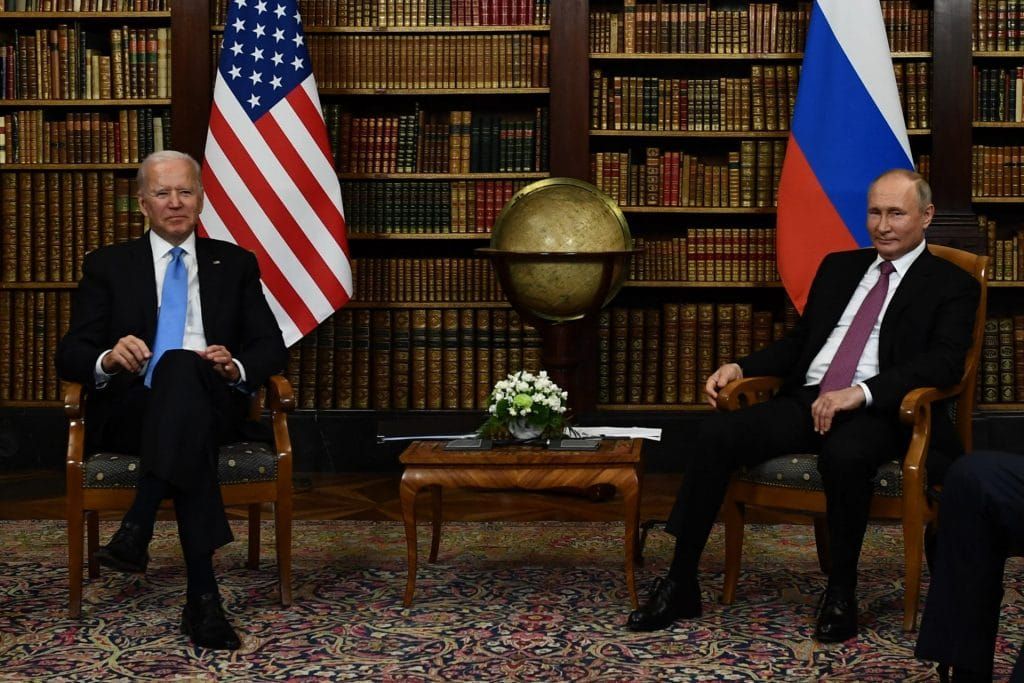 US President Joe Biden (L) and Russian President Vladimir Putin (R) pose for press ahead of the US-Russia summit at the Villa La Grange, in Geneva on June 16, 2021. (Photo by BRENDAN SMIALOWSKI/AFP via Getty Images)
US President Joe Biden (L) and Russian President Vladimir Putin (R) pose for press ahead of the US-Russia summit at the Villa La Grange, in Geneva on June 16, 2021. (Photo by BRENDAN SMIALOWSKI/AFP via Getty Images)
Sooner, or later, the war in Ukraine will end. We all hope that it will not conclude with a strategic nuclear exchange like the 1983 made-for-TV movie, The Day After. Assuming it does not, the United States will be confronted with the question of how it should proceed to construct a stable relationship with Russia. The alternative, greater instability, would bring unacceptable risk. Furthermore, quietly floated proposals for enhanced stability may help end the war sooner.
Strident voices are already floating the idea of doubling the US defense budget and increasing our reliance on nuclear weapons. Hopefully, instead we will respond as in the aftermath of the Cuban Missile Crisis and of the war scare of 1983, when a NATO military exercise may have provoked Soviet leadership to consider a pre-emptive nuclear strike on the United States. The well-founded fear of nuclear annihilation engendered by the Cuban Missile Crisis gave rise to the Limited Test Ban Treaty under John Kennedy, the Nuclear Non-Proliferation Treaty under Lyndon Johnson, and the Anti-Ballistic Missile Treaty under Richard Nixon. Similar fear engendered by the events of the early 1980s gave rise to the Intermediate-range Nuclear Forces treaty under Ronald Reagan, the Presidential Initiatives under George H.W. Bush and Boris Yeltsin that resulted in dramatic reductions in US and Russian nuclear arsenals, and ultimately the strategic arms reduction treaties that culminated in New START under Barack Obama.
The US policy goal the day after the war in Ukraine ends should be to assure that the circumstances that gave rise to that devastating war should never recur. It is understandable that some will say that we should not negotiate with war criminals, but short of defeating Russia in a world war we will have no other choice. Here, I do not address the settlement between Ukraine and Russia. As President Biden has said, this is up to Ukraine. But five arms control and disarmament initiatives outlined below could contribute to stabilizing the relationship between the United States and Russia.
Conventional forces in Europe. The first of these initiatives, a new CFE agreement, seems obvious. The Russian build-up of conventional forces near the border of Ukraine was both an attempt to pressure Ukraine and a pre-requisite for invasion. In a parallel sense, the stationing of NATO forces close to the borders of Russia is perceived as a threat. Separating forces should be an element of European policy going forward. The original Conventional Forces in Europe treaty was suspended over disputes about its implementation. Leaders of the West and in Russia should be able to learn from their errors and structure a modern version of this agreement that gives assurance to both sides. It should include limitations on military exercises close to sensitive borders. There is no problem verifying such an agreement through satellite surveillance, but a return to a modernized Open Skies agreement would be a confidence-building measure for those states without access to satellite data.
Intermediate-range nuclear forces in Europe. A new INF agreement could be focused on what matters, nuclear-armed missiles, not all short and intermediate range missiles, as in the inaccurately named original treaty. Nuclear-armed missiles can carry roughly 100,000 times more explosive energy than conventional ones, putting them in a separate class. The new agreement could also be focused just on Europe, defined as ranging from Portugal and Ireland to the Urals, with the idea of reducing the risk of a rapid, decapitating strike on Moscow, Paris, or London. To mitigate the concern that either NATO or Russia intends to fight a nuclear war with theater nuclear weapons, all such non-strategic weapons could be withdrawn from these boundaries of Europe. Such an agreement would have balanced advantages. Intermediate range missiles in Europe are not a threat to US command and control, as they are to Russian systems, so the agreement advantages Russia. On the other hand, Russia has many more non-strategic nuclear weapons than NATO, so a pullback of Russia’s theater nuclear weapons would advantage the United States.
Perhaps one lesson from the war in Ukraine is that an invasion takes time, so there is no need to forward position theater nuclear weapons, for example as recently proposed by Poland. Furthermore, forward positioning creates a use-them or lose-them pressure that makes it more likely that the nuclear threshold will be crossed early in a war. The proposed agreement could be verified by national technical means, such as satellites, combined with local inspections verifying the absence of nuclear material in suspected storage bunkers.
Missile defenses. A new anti-ballistic missile, or ABM, agreement is a necessity to reduce the pressure on both Russia and China to diversify and grow their nuclear arsenals. Both states are concerned that the United States could one day develop a first-strike capability that would be able to destroy much of their strategic arsenals, and it would be backed up by missile-defense capabilities that could mop up a ragged second-strike response. This concern is reasonably underpinned by the fact that the United States has tested an interceptor launched by an Aegis destroyer against an ICBM-like target. The United States is planning to have 65 Aegis destroyers by 2025, and each can carry up to 96 missiles. This could constitute an apparently formidable ABM system, much more extensive that the Aegis Ashore systems installed in Romania and under construction in Poland. Thus, a new anti-ballistic missile agreement must verifiably limit the total number of ICBM interceptors.
Sadly, Russia and China are concerned that US missile defenses might someday work, while the reality is that they are not likely to work in the foreseeable future. Their main effects are to provide the United States with a false sense of security and, simultaneously and ironically, to provoke the diversification and growth of Russia’s and China’s nuclear arsenals. Resolving the paradox—that ABM capabilities reduce the national security of both parties—should be beneficial to Russia, China, and the United States.
New START+. The existing New START treaty will run out in February 2026. If no follow-on agreement is achieved, there will be no agreed limitation on US and Russian strategic weapons, allowing nuclear arsenals to grow again to the levels at the peak of the Cold War. A new agreement must be reached. Both the United States and Russia have about 400 warheads stationed on silo-based intercontinental ballistic missiles, and it is the policy of both sides that these missiles may be launched if they are perceived to be under attack, giving rise to another “use-them or lose-them” instability, which can lead to the disastrous, mistaken launch of nuclear-armed missiles in the fog of war or at a time of heightened tensions. It would be to the advantage of both sides if these missiles were eliminated.
The United States has argued that a New START follow-on treaty should include non-strategic nuclear weapons. However, counting weapons in each other’s bunkers would be problematic compared with verifying the absence of such weapons, as is proposed here to be included in a new INF agreement. Russia could see a shift of the location of its theater nuclear weapons—rather than a reduction in their numbers—as advantageous, in that it would allow Russia to retain what it considers a key element of its defense strategy. The new ABM agreement would reduce the need for the new strategic weapons that Russia has announced to counteract US anti-ballistic missile capabilities. In any event such nuclear-armed and nuclear-powered submarine drones and very long-range cruise missiles should be counted and limited under a New START+ treaty, as Russia has already offered for its strategic hypersonic missiles.
Nuclear declaratory policy. President Putin’s recent, barely veiled threats to use nuclear weapons in the Ukraine war bring to the fore concerns about nuclear declaratory policy. There are a range of options for making national policies on when nuclear weapons use might be considered more stabilizing. It would be most powerful if the leading nuclear weapons states, the P5 (China, France, Russia, the United Kingdom, and the United States), agreed on a common policy.
The P5 recently re-iterated the Reagan-Gorbachev statement that “nuclear war cannot be won and should never be fought.” Unfortunately, however, this statement does not have direct implications for nuclear use policy. If the P5 could agree on a common policy that was explicit in its limitations, this could be of great benefit toward predictability and stability. It will be difficult to get to an agreement that bans the first use of nuclear weapons, as US allies have reportedly resisted such a policy and Russia clearly feels that it needs nuclear weapons to defend against conventional attack from NATO. A policy under which nuclear weapons would only be considered in the case of imminent existential risk[1] might be more achievable. The need for all parties to accede to the Treaty on the Prohibition of Nuclear Weapons is more obvious now, but such accession would be even harder to achieve given the heightened level of distrust. How far the P5 can get towards a common nuclear declaratory policy that provides stronger guardrails against the use of nuclear weapons will depend on many factors, but an effort in this direction is surely merited.
In sum. At the time of writing, a vastly destructive war is raging in Ukraine. President Putin has issued barely veiled threats of nuclear use, giving rise to concerns that this war could lead to a nuclear holocaust. The war in Ukraine has been much more destructive than either the Cuban Missile Crisis or the war scare of 1983, both of which turned the world away from nuclear confrontation. Whether or not the day after the war in Ukraine sees the use of wise judgment, or growing danger, is up to both sides. The only alternative to establishing greater stability in the US-Russia relationship is greater risk.
Notes
[1] https://www.jstor.org/stable/20045532?seq=1, https://thebulletin.org/2021/10/bilateral-strategic-stability-what-the-united-states-should-discuss-with-russia-and-china/, https://carnegieendowment.org/files/Perkovich_Vaddi_NPR_full2.pdf
Together, we make the world safer.
The Bulletin elevates expert voices above the noise. But as an independent nonprofit organization, our operations depend on the support of readers like you. Help us continue to deliver quality journalism that holds leaders accountable. Your support of our work at any level is important. In return, we promise our coverage will be understandable, influential, vigilant, solution-oriented, and fair-minded. Together we can make a difference.
Keywords: CFE, INF, New START, Russia-Ukraine, Ukraine, arms control, missile defense, no first use, nuclear declatory policy
Topics: Nuclear Risk, Nuclear Weapons








